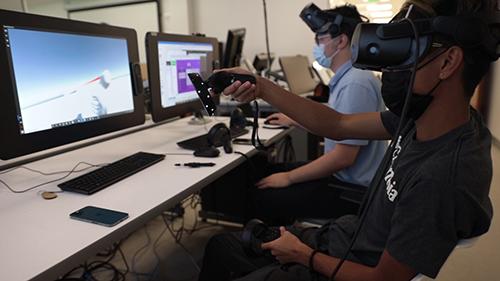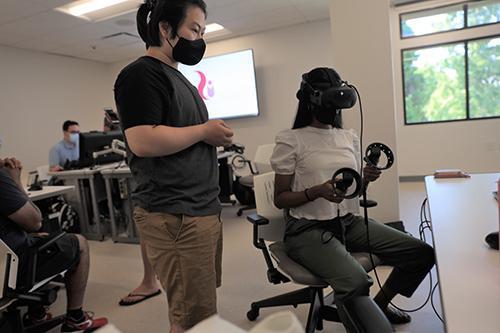The Past and Future of the Imaginarium

SCU’s virtual reality lab, which has influenced many students’ future career paths, is expanding its presence on campus.
by Sarah Stoddard ’23
The Imaginarium, Santa Clara University’s immersive virtual reality lab, will begin a new era this fall as part of the Sobrato Campus for Discovery and Innovation. In its new space, located in Heafey, the Imaginarium will begin working more closely with the Wiegand Advanced Visualization Environment, or WAVE, a high performance computing center on campus, which will allow for new collaborations and an increased ability to help people understand the broader, human-centered potential of data visualization and virtual reality.
Since it opened in 2017, the Imaginarium has provided an opportunity for students and faculty to create—from learning to digitally design games to engaging in creative coding, people in this space have worked at the intersection of art, design, and technology. For many students who have been involved in the Imaginarium, the space has played an incredibly important role in their time at Santa Clara as well as their lives after graduation. And now, the Imaginarium will be able to reach an even wider audience. “It was already a center of creative energy and community for students who had enrolled in digital design courses,” says Amy Lueck (English), one of the faculty directors. “Now we hope to make it a university-wide hub for research and collaboration around digital visualization technologies.”
Isabel Wu ’21 (Marketing and Studio Arts), who has worked with the Imaginarium since 2018, discovered essential knowledge and skills that have helped shape her career path. “The Imaginarium opened up the possibilities of graphics and digital art for me,” she says. “By learning the 3D programs, it encouraged me to teach myself how to use 2D digital art programs. These skills combined have elevated the work I am able to produce, especially applicable for my business major, where I have been able to combine my knowledge in marketing and art to land an internship with Hitachi Vantara.”

For Andrea Horvath ’21 (Computer Science and Engineering), the Imaginarium was also greatly influential in deciding her career path. “It has made me more determined to follow a career in VR or game development, as I've found that I really enjoy working in developing games and experiences,” she says. She knew she enjoyed programming before joining, but the Imaginarium showed her that she also enjoyed creating virtual experiences using her skills. “Being able to combine art with technical skills has been very rewarding, and seeing all parts of projects—art, narrative, code—come together throughout development is what continues driving me to seek a career in a similar field,” Horvath says.
Students who have been involved in the Imaginarium have found themselves a part of a great community on campus. “Being part of the community that has grown around the Imaginarium has been one of the best experiences I've had at SCU,” Horvath says. Now, faculty at the Imaginarium hope to expand its reach and encourage anyone on campus who is interested to join. “Students, faculty, and staff interested in learning more about VR/AR/XR, data visualization, game design, 3D modeling, UX/UI are all welcome at the new Imaginarium,” says David Jeong (Communication), another faculty member involved with the lab. He explains that being in this new space will allow for more people to be a part of the experience. “The Imaginarium will aim to maximize its inclusivity and accessibility for the SCU community,” he says.
This increased scope of influence and accessibility will be possible thanks to both the Imaginarium’s location in the new STEM complex on campus as well as its partnership with WAVE, Lueck explains. “With flexible monitors grouped in pods and an open space where people can gather to collaborate, observe, and discuss, we plan for the design of the new space to be a human-centered space distinct from other computer labs,” she says. Michael Taylor (Mechanical Engineering), a co-director of WAVE, says, “Co-locating WAVE with the Imaginarium facilitates the collaborative learning and discovery that is at the heart of the new STEM complex. Faculty and students from across campus will have an inviting space to discuss, visualize, and approach their projects in new, possibly transformative, ways.” Ultimately, in this new space, the Imaginarium, which has already influenced so many students’ lives, will be able to promote even more innovation and become a life-changing experience for many more in the SCU community.